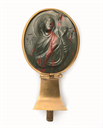Description
Among the roughly two hundred surviving Byzantine cameos, those carved from sapphire are the rarest. There are no more than a handful, including the Dumbarton Oaks cameo, and another in the Louvre, which was mounted in Napoleon’s crown after the treasury of the Abbey Saint-Denis was plundered during the French Revolution. Because so many carved gems were removed from their original contexts, and because so few can be securely dated from inscriptions, scholars rely on stylistic analysis to date them. In this case, Christ’s narrow head, slightly furrowed forehead, sloping shoulders, and almond-shaped eyes without irises are all features shared by other cameos dated to the twelfth century.
The practice of engraving gems, fashionable in antiquity for portraits, declined during the early Christian period, possibly because of changing attitudes toward personal adornment. Ancient cameos continued to circulate, however, and provided a basis for the revival of the art form in Byzantium from the tenth century on. At this time, carvers tended to favor iconic images of Christ, the Mother of God, or the saints. This image depicts Christ in a strict frontal pose, holding a Gospel book in his left hand, and raising his right hand in a Trinitarian gesture of blessing, a type known as Christ the Pantokrator, or Ruler of All. The epithet appeared in the Apocalypse, (e.g. Rev. 11:15-17; the English translation is usually “almighty” or “omnipotent”) and came to be contrasted with the Devil’s title of Kosmokrator (Ruler of the World). The image of the Pantokrator occurs frequently in monumental contexts in the twelfth century, such as the apex of domes in churches. This cameo was probably worn as a pendant to protect the wearer.
J. Hanson
Bibliography
Exposition internationale d'art Byzantin, exhibition catalogue, Musée des Arts Décoratifs, Palais du Louvre (Paris, 1931), 74, no. 84.
W. F. Volbach, G. Duthuit, and G. Salles, Art byzantin (Paris, 1933), 56f., pl. 49c.
Arts of the Middle Ages; a Loan Exhibition, exhibition catalogue, Museum of Fine Arts, Boston (Boston, 1940), 60, no. 200, pl. 4.
Bulletin of the Fogg Art Museum 10.4 (Dec. 1945): 108, esp. 108, fig. p. 106.
The Dumbarton Oaks Research Library and Collection of Harvard University, Handbook of the Collection (Washington, D.C., 1946), 73, no. 141, fig. p. 74.
"Reawakening at Dumbarton Oaks: The Golden Glories of the Byzantine and Early Christian Worlds," Art News 45.10.1 (1946): 15-19; 57-59, esp. 57, fig. X.
The Dumbarton Oaks Collection, Harvard University (Washington, D.C., 1955), 99, no. 216, fig. p. 102.
M. C. Ross, Catalogue of the Byzantine and Early Mediaeval Antiquities in the Dumbarton Oaks Collection, Vol. 1, Metalwork, Ceramics, Glass, Glyptics, Painting (Washington, D.C., 1962), 99, no. 120, pl. 58.
Handbook of the Byzantine Collection (Washington, D.C., 1967), 98, no. 336.
Byzance: l'art byzantin dans les collections publiques françaises, exhibition catalogue, Musée du Louvre, 3 November 1992-1 February 1993, (Paris, 1992), 283, 287.
G. Kornbluth, "The Heavenly Jerusalem and the Lord of Lords: A Sapphire Christ at the Court of Charlemagne and on the Shrine of the Magi," Cahiers archéologiques 49 (2001): 47-68, fig. 4.
A. Kirin, ed., Sacred Art, Secular Context : Objects of Art from the Byzantine Collection of Dumbarton Oaks, Washington, D.C., Accompanied by American Paintings from the Collection of Mildred and Robert Woods Bliss, exh. cat., Georgia Museum of Art (Athens, Ga., 2005), 59, no. 3, and cover.
R. Cormack, M. Vasilaki, and B. Mouseio, Byzantium, 330-1453, exhibition catalogue, Royal Academy of Arts, London, October 25, 2008 - March 22, 2009, (London: New York, 2008), 431.
G. Bühl, ed., Dumbarton Oaks: The Collections (Washington, D.C., 2008), 164, pl. p.165.
Exhibition History
Paris, Musée des Arts Décoratifs, "Exposition Internationale d'Art Byzantin," May 28 - July 9, 1931.
Boston, Museum of Fine Arts, "Arts of the Middle Ages," Feb. 17 - Mar. 24, 1940.
Cambridge, MA, Fogg Art Museum, "A Selection of Ivories, Bronzes, Metalwork and Other Objects from the Dumbarton Oaks Collection," Nov. 15 - Dec. 31, 1945.
Athens, GA, Georgia Museum of Art, “Sacred Art, Secular Context: Objects of Art from the Byzantine Collection of Dumbarton Oaks, Washington, D.C., Accompanied by American Paintings from the Collection of Mildred and Robert Woods Bliss,” May 15 – Nov. 6, 2005.




